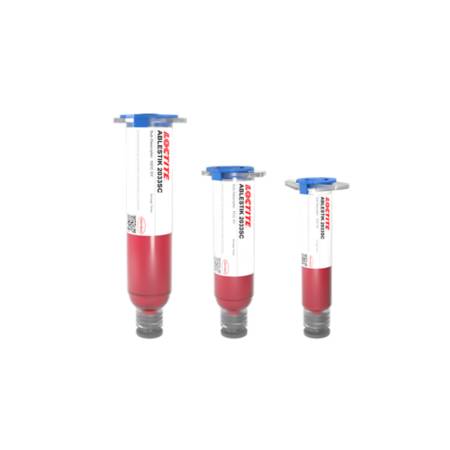LOCTITE ABLESTIK 2033SC
Harmonization Code : 3506.91.90.99 | Prepared glues and other prepared adhesives, not elsewhere specified or included; products suitable for use as glues or adhesives, put up for retail sale as glues or adhesives, not exceeding a net weight of 1 kg ; Adhesives based on polymers of headings 3901 to 3913 or on rubber; Other ; Other
Main features
- Low cure temperature
- Legacy smartcard product
- Optimized rheology
Product Description
LOCTITE ABLESTIK 2033SC die attach adhesive is designed for high throughput smart card bonding applications. It is compatible with various encapsulant chemistries. This monocomponent low bleed product has long work life and can cure fast at low temperatures, making it ideal for smart-card applications.
LOCTITE ABLESTIK 2033SC is a mature and price efficient product. Legacy smartcard products could and should be served by 2033SC. For new applications and snap cure materials though we suggest you take a look at LOCTITE ABLESTIK 2035SC and LOCTITE ABLESTIK 2035SCR.
Cure Schedule
- 90 seconds @ 110°C
Technical Specifications
| General Properties | |||||||||||
| |||||||||||
| |||||||||||
| Work life @25°C Work life @25°C Work life is the amount of time we have to work with a material until it is no longer able to be easily worked and applied on a substrate. It is based on the change in viscosity and it can rely on the application requirements. | 24 hours | ||||||||||
| Physical Properties | |||||||||||
| Thixotropic index Thixotropic index Thixotropic Index is a ratio of a material s viscosity at two different speeds in Ambient temperature, generally different by a factor of ten. A thixotropic material s viscosity will decrease as agitation or pressure is increased. It indicates the capability of a material to hold its shape. Mayonnaise is a great example of this. It holds its shape very well, but when a shear stress is applied, the material easily spreads. It helps in choosing a material in accordance to the application, dispense method and viscosity of a material. | 6.1 | ||||||||||
| Viscosity Viscosity Viscosity is a measurement of a fluid’s resistance to flow. Viscosity is commonly measured in centiPoise (cP). One cP is defined as the viscosity of water and all other viscosities are derived from this base. MPa is another common unit with a 1:1 conversion to cP. A product like honey would have a much higher viscosity -around 10,000 cPs- compared to water. As a result, honey would flow much slower out of a tipped glass than water would. The viscosity of a material can be decreased with an increase in temperature in order to better suit an application | 11,300 mPa.s | ||||||||||
| Chemical Properties | |||||||||||
| |||||||||||
| Electrical Properties | |||||||||||
| |||||||||||
| Mechanical Properties | |||||||||||
| |||||||||||
| Thermal Properties | |||||||||||
| |||||||||||
| Glass Transition Temperature (Tg) Glass Transition Temperature (Tg) The glass transition temperature for organic adhesives is a temperature region where the polymers change from glassy and brittle to soft and rubbery. Increasing the temperature further continues the softening process as the viscosity drops too. Temperatures between the glass transition temperature and below the decomposition point of the adhesive are the best region for bonding. The glass-transition temperature Tg of a material characterizes the range of temperatures over which this glass transition occurs. | 46 °C | ||||||||||



